Should Your Brand Launch a Podcast? Here’s How to Tell If It’s Worth Pursuing
- The following is a sample of my weekly newsletter, Playing Favorites. As my friend Ann Handley would say, it’s far more focused on the “letter” than the “news.” Every Friday, get one original idea, packaged as a question you can ask, focused on helping you make your audience’s favorite things. Plus, you’ll get a roundup of 3 things worth your time that week, our latest episodes, and exclusive discounts and access to our work. Subscribe here to join creative minds from Adobe, Shopify, the NY Times, the BBC, and thousands of small businesses, startups, and freelancers.
![]()
Most of the content we create offers what’s called transactional value. This is education and entertainment (they’re not separate things, by the way) designed to address a narrow need as quickly as possible. Think of transactional value as a quick injection of information. In other words, the audience’s objective is to acquire some information — and fast. Today, I want to write about why this can be helpful but very limiting to do our jobs well.
In the podcast world, you’ve encountered transactional value or transactional shows, I’m sure:
- Success tips.
- General advice or interview shows.
- Curated facts or news.
- Broad-topic banter (what some call “chat-casts”).
These shows are generic, endlessly available. and pretty darn forgettable. The source of the information almost doesn’t matter. Pick one, get the information, and move on. It’s almost as if the listening experience itself doesn’t matter, nor does the relationship to the host or brand. For the audience, the value is having listened in the past.
These types of experiences make me think of those crazy high-tech chairs from the movie The Matrix, where the characters sit down, plug their brains straight into a computer, and instantly download some knowledge. (“I know Kung fu!”)
That would be preferable to having to endure most transactional podcasts. And that’s our problem.
Here are a few (fake) transactional shows:
The Coffee Lover’s Podcast: Talking about new things in coffee, how to make great coffee, and interviews with coffee industry insiders.
Business Trends: A Podcast About Business Trends: Business experts share important business trends from the world of business. #business
Real Awesome Real Estate: Real awesome real estate agents share real awesome tips so you can build a real awesome real estate business yourself. (Awesome!)
The problem with transactional value is that you (the provider of the value) anchor your audience to the acquisition of knowledge. (“Want this? We sell it!”) Their objective is to simply obtain something and move on, not spend meaningful time with you.
If you really think about it, the best case scenario for a transaction is you don’t need to endure it at all. You’re already on the other side of it. You already have whatever is on offer. In our work, that means the best case scenario for transactional content is they don’t need it. They already know or possess what you offer. The information is already in their brains, like they sat in the chair from the Matrix — or perhaps found one of the endless other options from competitors of yours. In the information age, it’s pretty impossible to “out-inform” anyone. Information is a commodity.
As a result, when you offer “some information” (just like everyone else), your audience would rather NOT endure your content in order to acquire it. That’s why you also need to offer an experience.
Think about your favorite podcast, or video series, or TV show, or book, or movie. Do you want the synopsis alone, the information? Or do you also want the experience? Is your preference to have already completed it in the past … or to spend some quality time with the thing?
Here’s the question I want you to ask more often in your work…
“Is our value to the audience the information we provide … or the experience?”
We can use a helpful visual tool to understand this idea, comparing the two types of value our work could provide. (I’ve mentioned one type already: transactional value. We’ll get to the second type in a moment.)
I call this visual the Consumption Preference Spectrum. It shows us a range of possibilities for how our audience might like to receive our work based on what we’re offering.
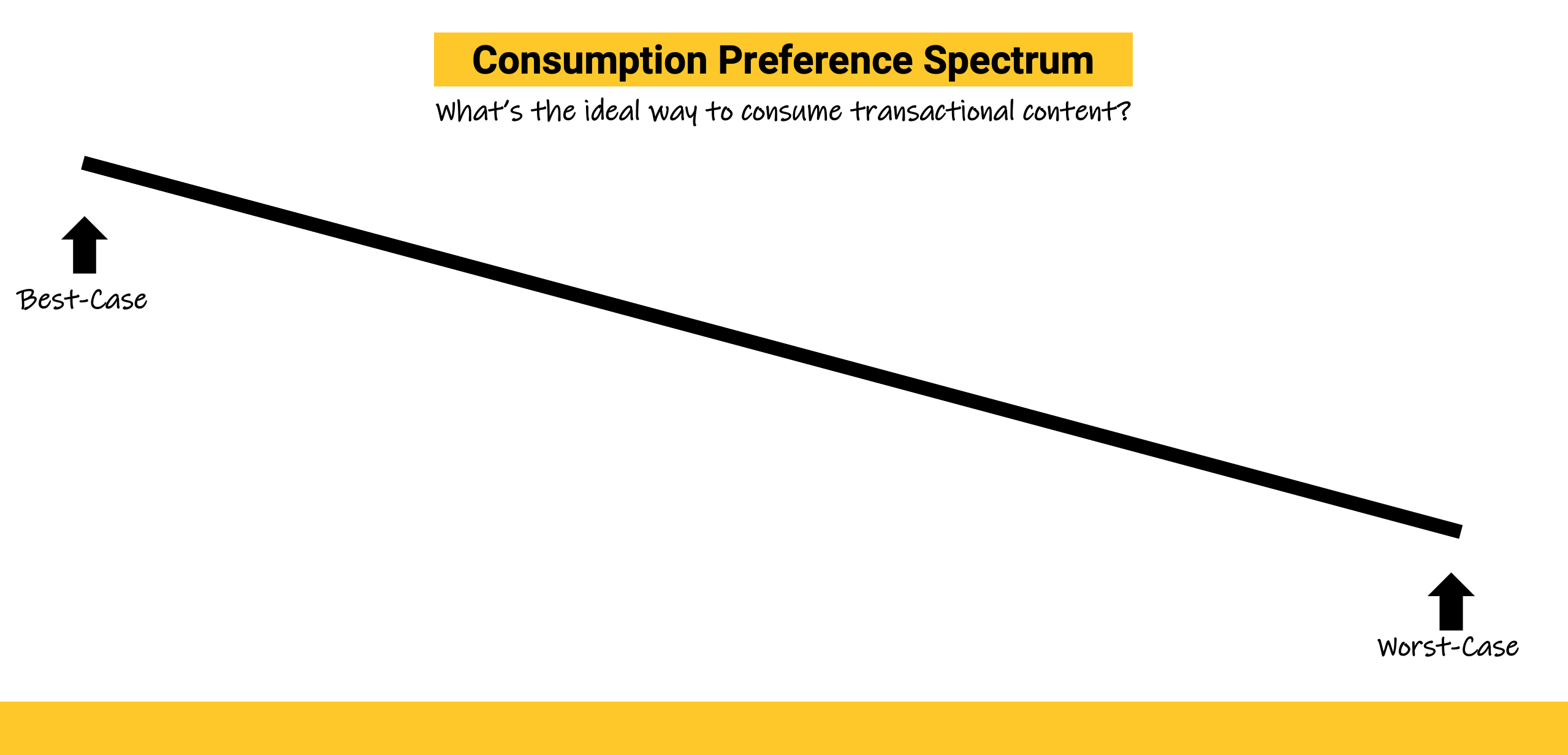
Let’s start with transactional value. When you merely offer “some information,” and thus your audience’s objective is to acquire information, what would be the best-case scenario to experience that kind of content … and the worst-case scenario?
Think about your own consumption preferences as we move through this spectrum.
The best-case scenario is you already know it.
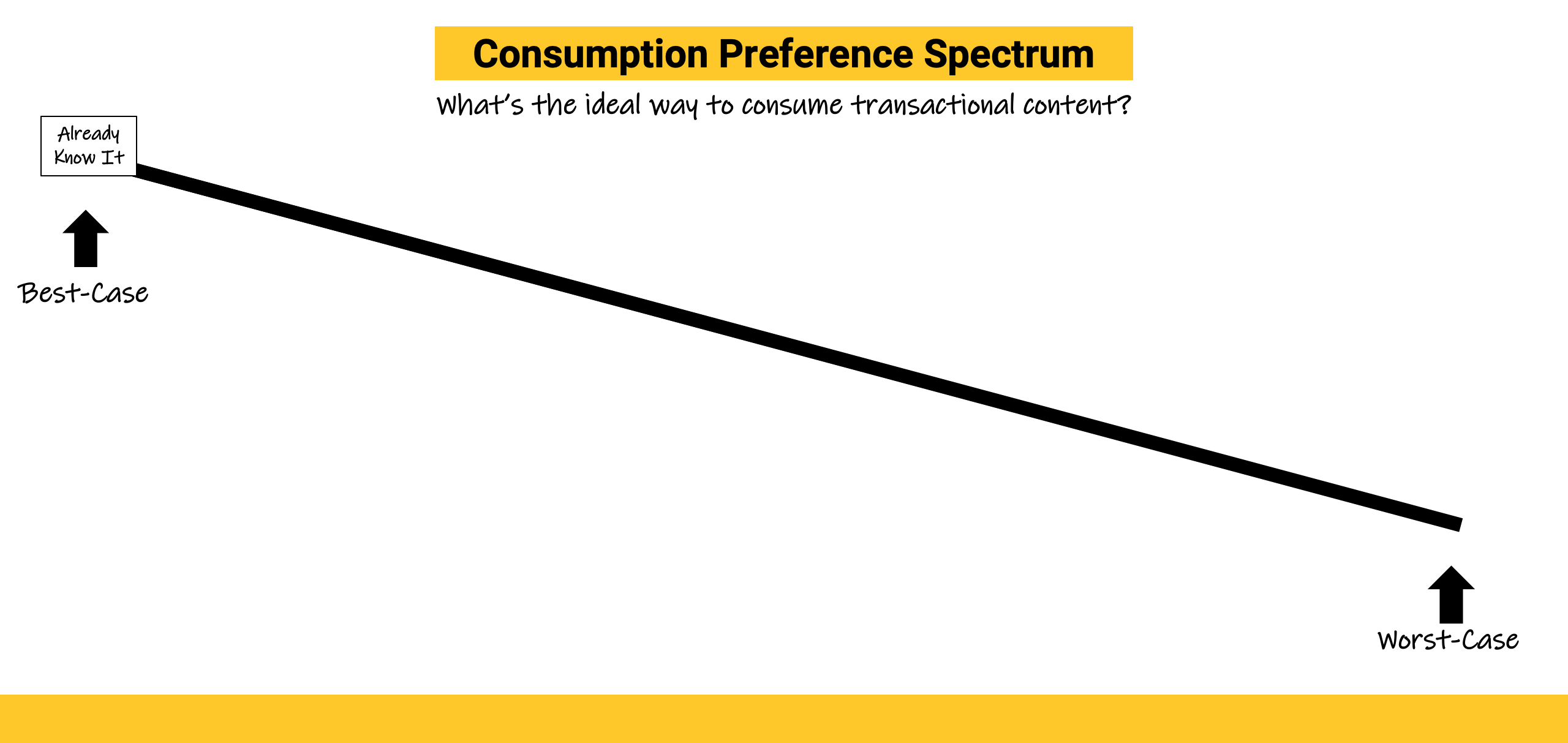
You don’t need the Business Trends podcast with someone else’s round-up of news from the business world from last week. You already know what happened. You don’t need any awesome real estate tips. You’re already awesome. (And, honestly, I don’t need a whole podcast episode titled 7 Tips and Tricks for Building Newsletters. I already have the honor of writing to some esteemed subscribers each week. #awww #OMGPleaseSubscribe)
Just think about it: The best-case scenario when you offer your audience transactional value is they don’t need you. Rut roh!
(Oh, and the second-best option is fictional. It’s the chair from The Matrix. I can download this stuff straight to my brain in mere seconds and be on my way? Yes please.)
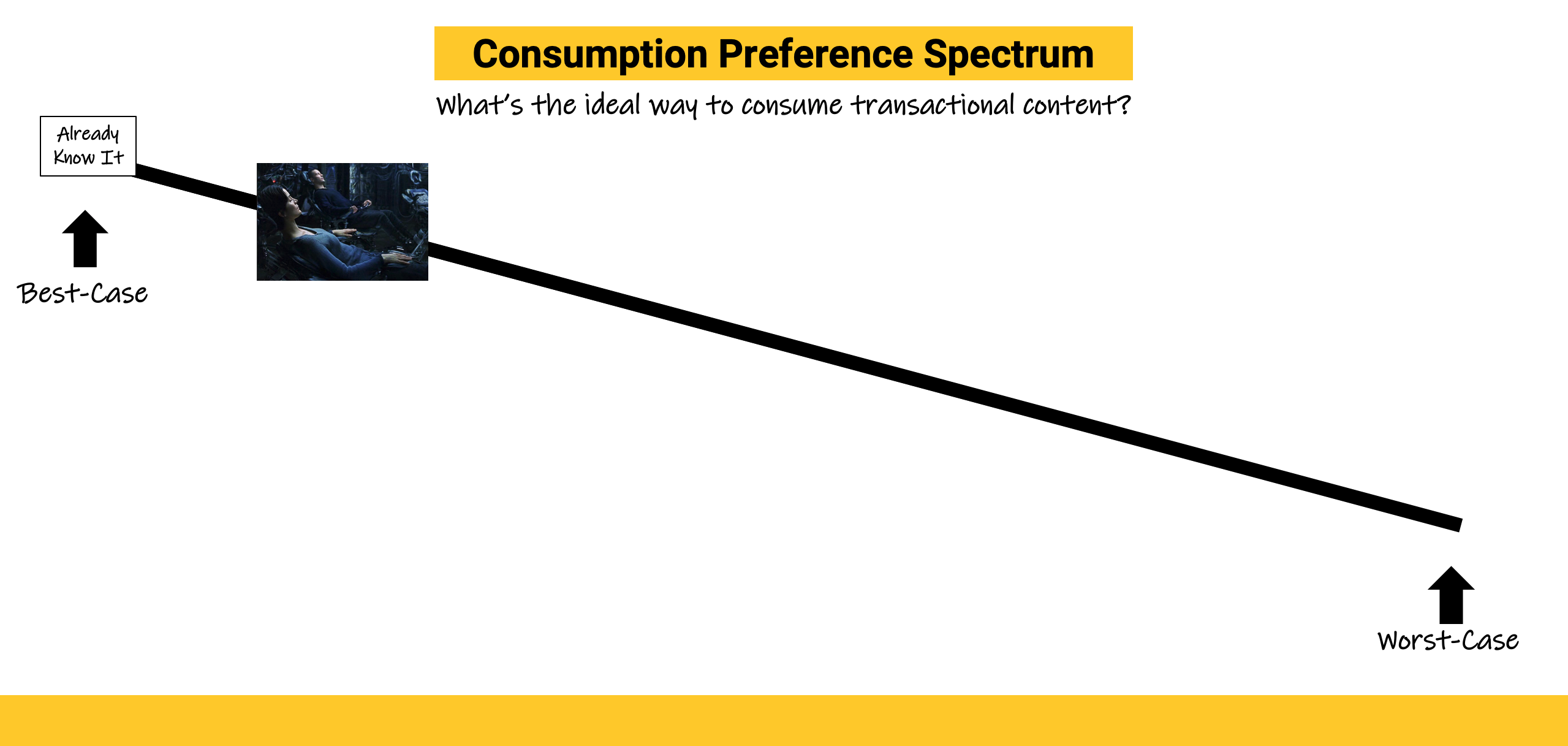
Moving towards the middle, a decent option is to ask a friend. If all you want is to acquire the information, just swivel your chair or (more likely, especially today) text or DM or email someone. They’ll tell you what you need to know, and you’re done. Boom!
Getting worse in terms of ideal experiences is to follow a checklist. That’s still nice and quick, though not as easy as just asking someone. Still, you don’t need a lengthy experience to acquire the information. Here are some nice, neat key takeaways, a bulleted summary, or a list of tips and tricks. Wunderbar!

Next, it starts to feel painful: You just want to acquire the info, but you’re asked to read a whole article?!
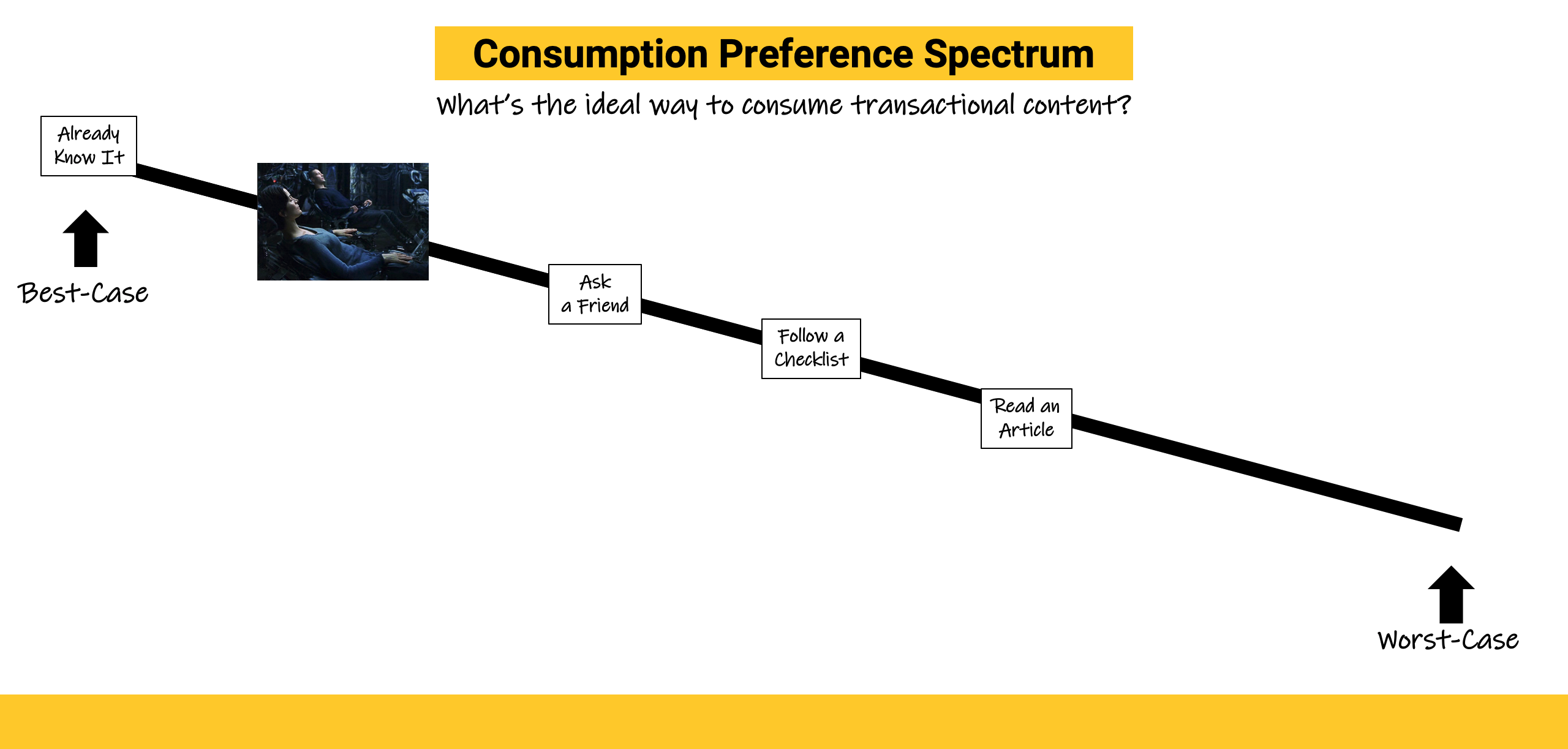
This makes me think about finding recipes online. Ever find yourself on a food blogger’s site? They open with those lengthy diatribes about the dish, their love of the ingredients, and their memories of cooking it. Honestly, just give me the better-case scenario: the recipe, i.e. the checklist I’m there for. I don’t need 1,000 words on your love of okra.
Moving further down the spectrum, the second-to-worst option is to listen to or watch an entire episode of a show. This is a high-friction, high-time-investment type of activity, but all you really want is to quickly finish a transaction. You mean to tell me I need to spend 10, 20, 30, 45, SIXTY minutes with something JUST to get the information I really want?! Barf.
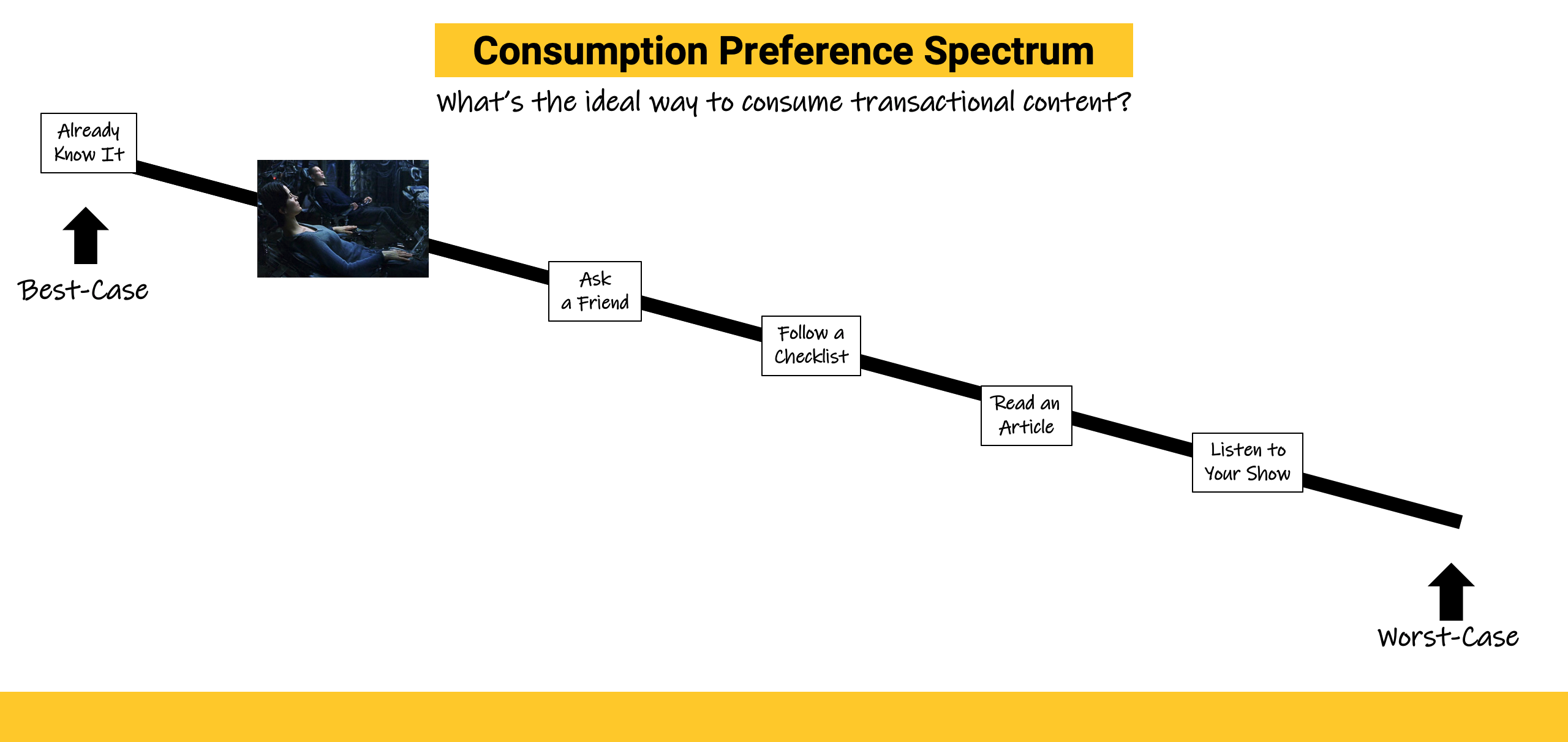
And the worst option is you’re forced to give up. Don’t even bother. You want the information, but there’s too much friction between you and it. Sigh…
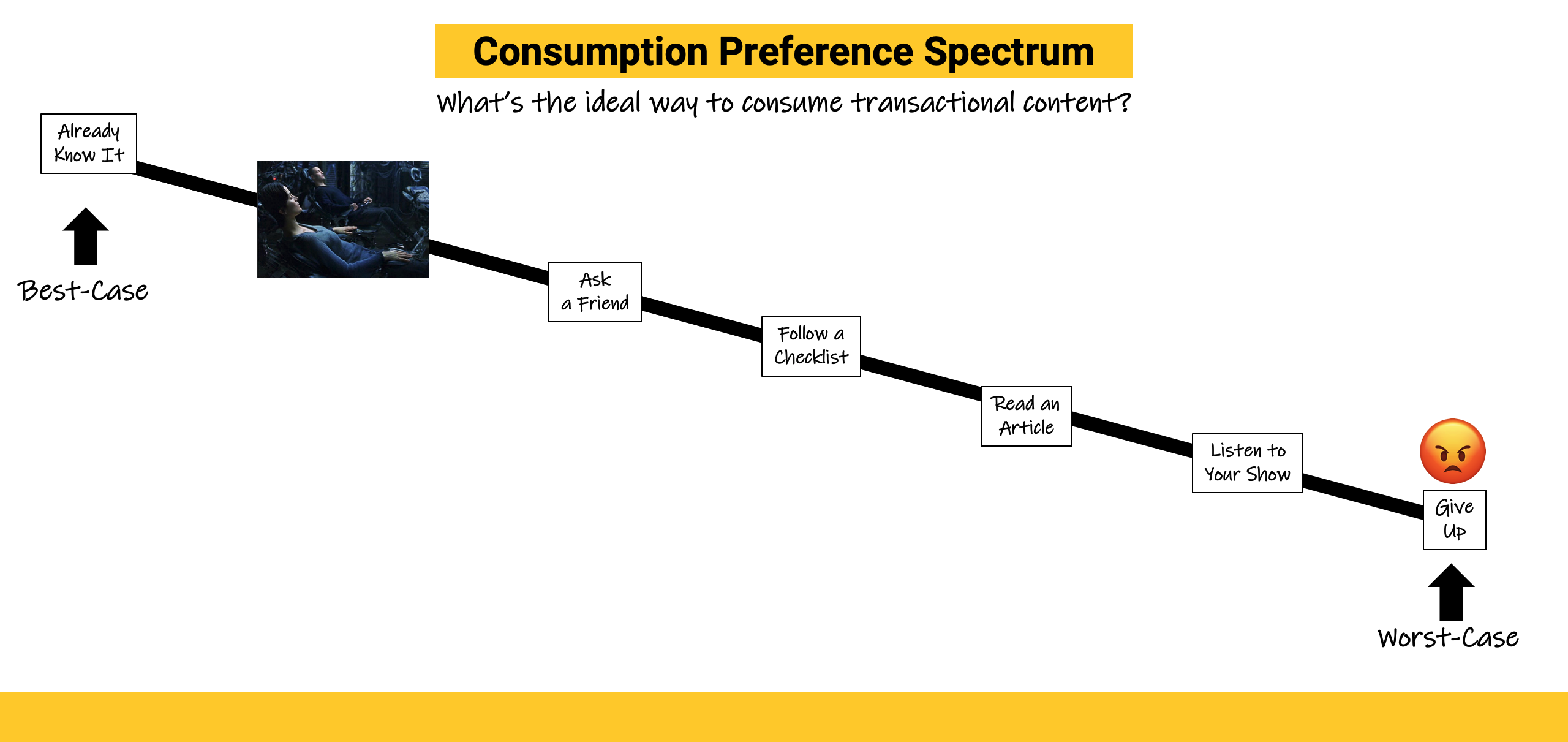
If your show is right next to the option “give up”???? You got problems.
You wouldn’t want the grocery clerk to tell you their life story for an hour when all you want is to buy some bread. But most of our work ends up feeling like that for our audiences, all because we keep offering transactional value.
We force our audience to endure an experience that is NOT the ideal experience for the type of value we offer. They’d rather read an article, or get a checklist, or just ask a friend, than actually spend time with our shows. And THAT is the reason our shows don’t resonate or grow.
So how do we create something with the express goal of earning more time with our audiences? We can’t offer transactional value. We have to offer something else: a transformational experience.
Creating transformational experiences
Transformational value is a type of value which provides lasting, fundamental change.
It’s not The Coffee Lover’s Podcast. It’s Fueled by Death Cast from Death Wish Coffee, which is all about how death motivates people to live and pursue their passions. Yes, they cover topics or talk to individuals you’ve heard on other shows — but NOT like you’ve heard them on this show, because they’re all about legacy and passion and change, not informational. They’re not a transactional show. They provide a transformational experience (and, yes, it’s still “just “an interview podcast).
Rather than create Business Trends, create a show like ZigZag from TED and host Manoush Zamorodi. The description offers a glimpse at the transformation: Discover new ways we can align our ambitions with systemic change that’s good for our fellow human beings, with profiles of dynamos reinventing business, their industries, and even capitalism in the name of humanity. It will change the way you see your work and yourself.
Instead of Real Awesome Real Estate, try The Walkthrough from HomeLight (and, full disclosure, a former workshop student of ours, Matt McGee). Matt’s beliefs as written to me during the workshop: While most of the industry believes in replacing agents with technology, we believe the human element is absolutely necessary to the process. We want to enable agents to be better at their jobs, so they become more valued by the buyer/renter.
Transactional content can help people. Transformational experiences can change them.
The entire point of a transformational show is to spend time with it — the experience is the point, not the quick injection of value.
If part of YOUR value is actually spending time with your show, you might stand a chance at doing your actual job: earning trust and love. Without the trust and love of your audience, nothing else you aim to do will happen. That’s the job. That’s the work. That’s the challenge.
The experience must be the point. Your show should not be so easily replaced by asking a friend, or a checklist of takeaways or steps, or a summary in an article. The experience is what earns trust and love, and (thanks to word of mouth) the experience is what can do the growing.
Let’s reverse the Consumption Preference Spectrum quickly, to understand how people’s preferences change when we offer transformational experiences, not transactional content. We can basically flip the order from last time:
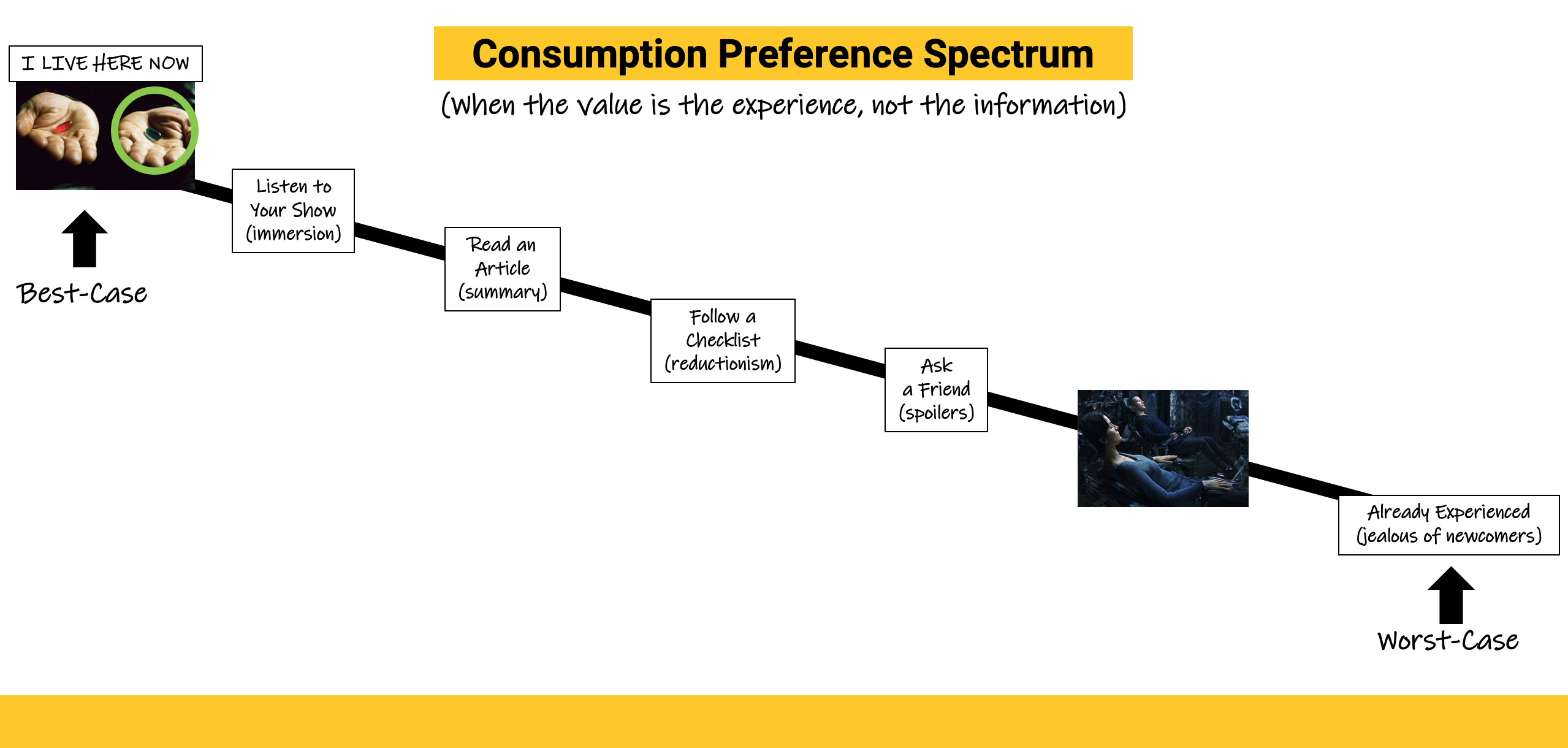
With trarnsactional content, the best-case scenario is you don’t need it or already experienced it. But here, with a transforrmational experience, that’s now the worst-case scenario. You’re jealous of newcomers who get to join for the first time. (I wish I hadn’t already seen Game of Thrones. How much better would my quarantine be right now?! I’m jealous of my friends Jon and Al who just told me they haven’t seen that show yet.)
The second-worst scenario is to get plugged into the Matrix chair. You get a quick hit of something delicious, and you want back in. Wait, more! I want more!
Then, asking a friend becomes a pretty bad scenario, too. What used to be super helpful because it was so quick and painless is now painful: spoilers. Don’t tell me! Don’t ruin it! I want to experience it firsthand!
A decent option is to read or follow a checklist, but really, it feels overly reductionist, or like a distant echo, a summary that doesn’t really give you what you want: immersion.
When someone provides a great experience, you want to be immersed in it. Spending more time with it is not only a nice-to-have, it feels kind of like a must-have. (Seriously, when will HBO be launching the Game of Thrones prequel? I want to spend more time immersed in that world! Partly because I love it. Partly because [gestures to our actual world].)
Shows — not just GoT — are built expressly for immersion. They’re all about time spent, resonance, and depth. They are not good vehicles for quick transactions of information — not at their best, anyway. To create a transactional podcast is to miss the true power of the medium. It’s immersive.
Honestly, the only content that feels better is to take the blue pill. Put me back in the Matrix forever!
None of us need to create Game of Thrones or even produce our work with all kinds of eye- or ear-catching techniques. But we can absolutely offer transformational experiences. We can stop pandering to the simple questions and near-term needs people ask for or think they want, and give them what we know they need. We can have a point of view, a belief, a big idea. We can create things that don’t just answer questions or offer quick tips or distractions. We can craft content that feels more like a journey, with us as the guides.
We’re here to push others to be better, to challenge the conventional wisdom, to make things that make a difference.
That’s the goal, when you really think about it. Don’t make some content. Make a difference.
As you leave the friendly (if lengthy) confines of this email-turned-article and start thinking about your work, remember: Information is a commodity. Experiences can be proprietary. You can’t out-inform. You might out-transform.
Ask yourself:
“Is our value to the audience the information we provide … or the experience?”

Founder of Marketing Showrunners, host of 3 Clips and other podcasts and docuseries about creativity, and author of Break the Wheel. I’m trying to create a world where people feel intrinsically motivated by their work. Previously in content marketing and digital strategy at Google and HubSpot and VP of brand and community at the VC firm NextView. I write, tinker, and speak on stages and into microphones for a living. It’s weird but wonderful.
Get in touch anytime: jay@mshowrunners.com // Speaking inquiries: speaking@unthinkablemedia.com

